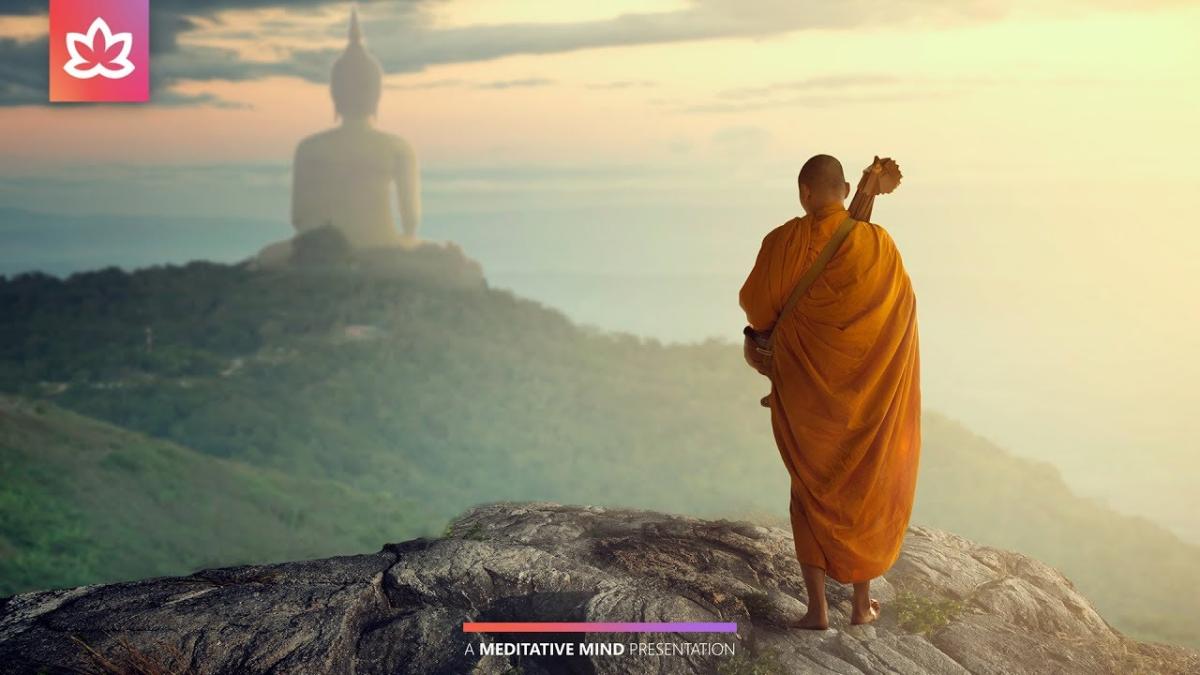One person like that
#mantra
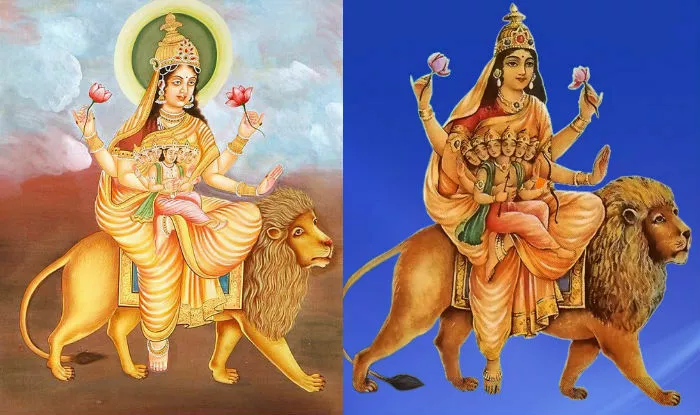
#navratri
13 April, 2024 Saturday Panchami #Orange #Skandamata Puja
#Goddess Skandamata rides a ferocious #lion and carries the many-headed baby #Kartikeya in her lap. The goddess has four hands with the right hand in the Abhaya #Mudra. A crescent #moon of Lord #Shiva can also be found on her forehead. She sits on the #lotus flower and because of that Skandamata is also known as Goddess #Padmasana. Red-colored flowers are her favorite.
Navratri 5th Day Puja Vidhi
For the purpose of Kundalini Jagaran worshipers who are worshiping NavaDurga, on Navratri day 5 is done by the sadhana of the pure chakra. In order to penetrate this cycle, the seeker must worship Skanda Mata with proper Vidhi-Vidhan. Sitting on the holy seat of Kush or blanket for worship, you should start the puja process in the same way as you have done in Kekar days, then you should pray to Goddess with this mantra "Sinhasanganata Nitya Padma Ashtakarwar Shubhadastu Sada Devi Scandamata Yashaswini. Now worship Skandmata by Panchapur vidhi. The fast on this day is said to be fruitful. Jai Bhakta Devi Skanda.
Significance
Devotees receive the blessings of the Goddess who worship the mother with devotion and affection. The wishes of the devotee are fulfilled with the grace of Goddess Skandamata and happiness, peace & prosperity remain in the house.
Navratri 5th Day Aarti and #Mantra
Om Devi Skandamatayai Namah.
Simhasanagata Nityam Padmanchita Karadvaya,
Shubhadastu Sada Devi Skandamata Yashasvini.
Ya Devi Sarvabhuteshu Ma Skandamata Rupena Samsthita,
Namastasyai Namastasyai Namastasyai Namo Namah.
Worshipping Skandamata on the fifth day of Navratri holds great significance. Skandamata is believed to bestow salvation, power, and prosperity upon her devotees. She can even grant wisdom to the illiterate. Those selflessly devoted to her attain the achievements and riches of life.
Her worship brings a twofold blessing, as the devotee not only worships Skandamata but also automatically worships Lord Skanda, her son in her lap. Thus, devotees enjoy the combined grace of both deities.
Skandamata is linked to the #heart #chakra which symbolizes #love, compassion and also promotes emotional balance and harmony.
One person like that
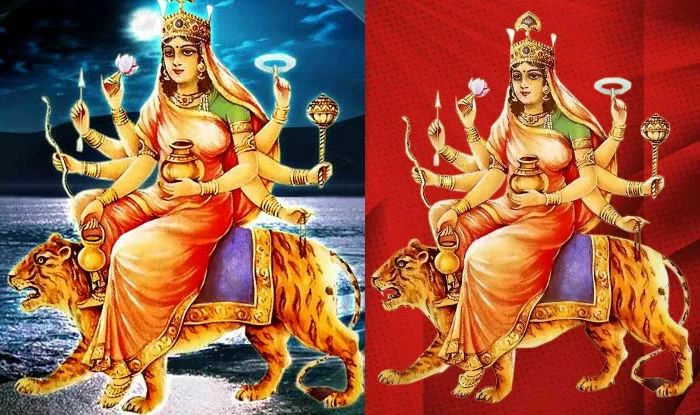
12 April, 2024 Friday Chaturthi #Grey #Kushmanda Puja
The fourth day of the Navratri festival is dedicated to #Goddess Maa Kushmanda, during which the fourth form of the nine incarnations of Goddess #Durga is worshipped. The worship of #Maa-Kushmanda develops intelligence and increases decision-making power in life.
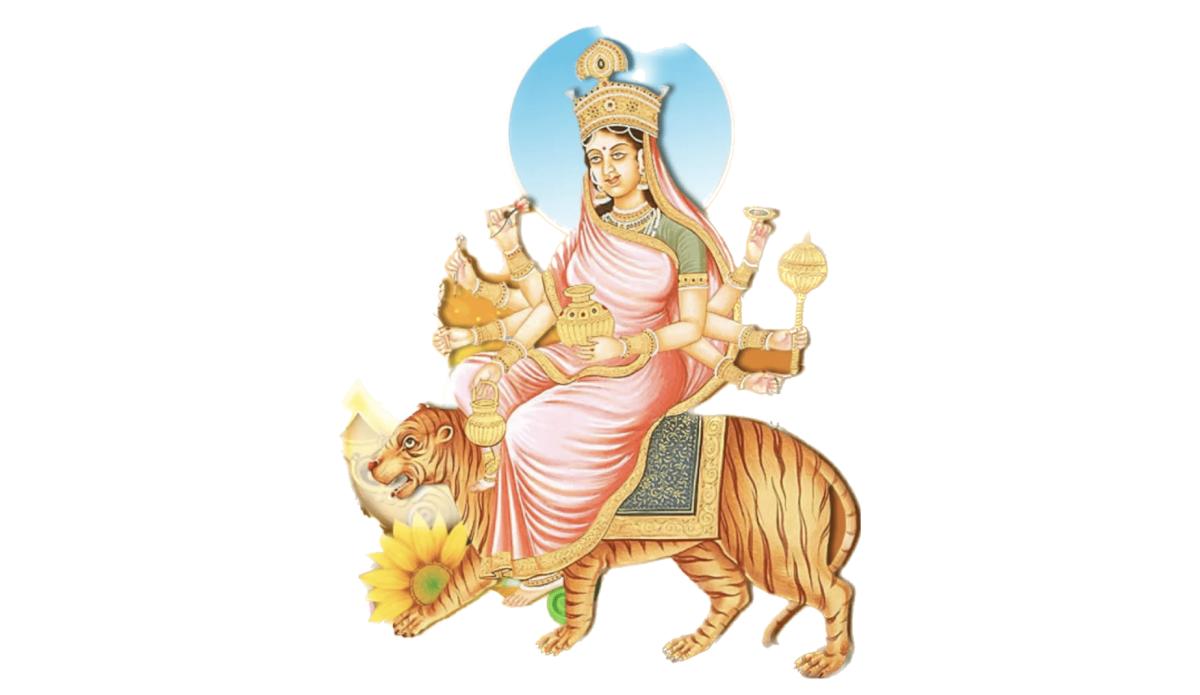
Maa Kushmanda is very fond of the sacrifice of Kumhada कुम्हड़ा फल (Also known as Petha, Ash Gourd or Kumahada) and in Sanskrit, Kumhada is called Kushmanda, that is why this form of Maa Durga is called Kushmanda. It is believed that by worshiping Maa Kushmanda in Navratri, all the diseases, sorrows and fears of the seeker are removed and he gets infinite grace and desired boon of the Goddess.
There are many forms of Goddess Durga, but the form of Maa Kushmanda is among the most striking; she radiates as brightly as the sun.
The mantra of Kushmanda Maa :
Maa Kushmanda resides in the Anahata Chakra so, she is worshipped by meditating in the Anahata Chakra. Through her blessings, her devotees are able to overcome diseases, evil eyes, and grief. She grants fame, strength and longevity to her devotees who chant the following mantras:-
सुरासम्पूर्णकलशं रुधिराप्लुतमेव च। दधाना हस्तपद्माभ्यां कुष्मांडा शुभदास्तु मे। (Surasampurnakalasham Rudhiraplutmev Ch; Dadhana Hastapadmabhayam Kushmanda Shubhadastu ) अमृत से परिपूरित कलश को धारण करने वाली और कमलपुष्प से युक्त तेजोमय मां कूष्मांडा हमें सब कार्यों में शुभदायी सिद्ध हो।
2. या देवी सर्वभूतेषु तुष्टि-रूपेण संस्थिता।
नमस्तस्यै नमस्तस्यै नमस्तस्यै नमो नमः॥
Her #beej #mantra is ॐ ऐं ह्रीं क्लीं कूष्मांडायै नम: । (Om Aim Hreem Klein Kushmandaai Namah).
- The devotees can also recite Siddha Kunjika Stotra to please Maa Kushmanda.
The story about Maa Kushmanda:
It is believed that the universe began as a dark space and that Goddess Kushmanda produced the Cosmos with her smile from that dark space. Kushmanda is believed to be the #source of direction and energy for the Sun. Kushmanda is believed to be the source of direction and energy for the Sun.
She is known as “Kushmanda,” which is derived from the words Ku (little), Ushma (warmth), and Anda ( #egg), referring to the person who created the universe as a “Little Cosmic Egg” filled with energy and warmth.
She also created Devi #Mahakali, Devi #Mahalaxmi, and #Devi #Mahasaraswati. Maa Kushmanda is also known as Adiswaroopa and #Adishakti.
She has eight arms, she is also known as Ashtabhuja, which means goddess with eight hands. Kamandal, bow, arrow, lotus flower, nectar-filled urn, chakra, and mace are held in each of her seven hands, respectively and in the eighth hand, there is a rosary that grants all siddhis (perfectionism) and prosperity to her devotionalists.
How to pray Maa Kushmanda?
On the fourth day of Navratri, Malpuas (traditional north Indian pancakes made with wheat flour, jaggery or sugar, and cardamom powder) should be offered to Goddess Kushmanda. Offerings of Red bangles, red flowers, and red dress should be made because these are very dear to the Goddess. During the time of Maa Kushmanda’s prayer, devotees should sit in the green asana.
She is the happy manifestation of Maa Durga better known as the “Smiling Goddess”, therefore, Maa Kushmanda is synonymous with happiness. Those who worship Maa Kushmanda are blessed with happiness, prosperity, an abundance of knowledge, good health, and long life. In this form of Durga, darkness is believed to be eradicated from the world by her #smile.
The worshipers of Maa Kushmanda enjoy good vision, mental freedom, and positive social standing.
One person like that
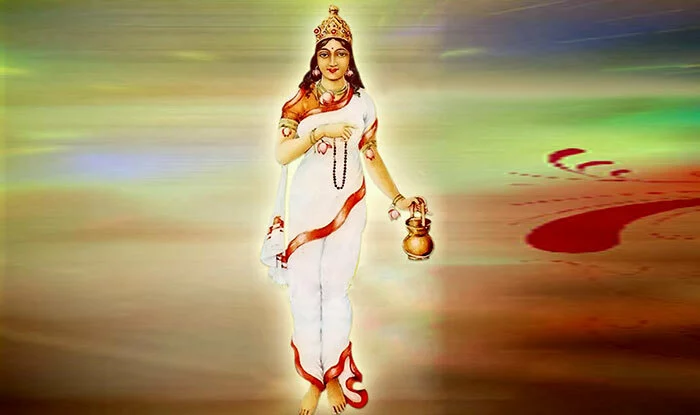

10 April, 2024 Wednesday Dwitiya #Yellow #Brahmacharini Puja

#Mantra
Om Dadhana Karapadmabhyamakshamala Kamandalu
Devi Prasidatu Mayi Brahmacharinyanuttama
Om Devi Brahmacharinyai Namah ॥
Significance
It is believed that the individuals who worship Maa Brahmacharini are granted peace and happiness. She is said to control Lord Mangal, the controller of fortunes, and provides her followers with wisdom and happiness.
Maa Brahmacharini is worshipped on the Second day of Navaratri. Maa Brahmacharini performed strict ‘Tapa’ (penance). In Sanskrit, “Brahma” means Universal Self Spirit, Absolute Reality often used in connection to tapa or tapasya (penance) and “Charini” means performer. Brahmacharini means “Goddess who practices devout austerity”. In the magnificent embodiment of Goddess Durga, She enlightens us with divine knowledge and grace. Brahmacharini Mata is also known by other names such as “Devi Yogini”, “Uma”, “Parvati”, “Tapascharini” and “Aparna”. According to Vedic texts, Brahmacharini is a feminine version of a Devi who performs sacred religious practices.
Maa Brahmacharini bestows the boon of love, loyalty, wisdom, and knowledge to Her devotees. Those who worship Her with utmost devotion, are blessed with calmness and happiness in their life. It is believed that she governs Planet Mars (Mangal). She is worshipped to remove Mangal Dosh and the problems resulting from unfavorable position of Mangal in the horoscope. Worshipping Maa Brahmacharini bestows devotees with values of devotion, virtues, nobility and solitude.
Brahmacharini Maa Vrat Katha
Maa Brahmacharini was born as Devi Parvati to Lord Himavan and Devi Menavati in the Himalayas. She blossomed in a beautiful princess, full of wisdom and grace.
There are many versions of legendary tales, but as mentioned in the Holy Puranas, Devrishi Narad influenced Devi Parvati with thoughts to marry Lord Shiva as Her divine consort. Devrishi Narad also guided Devi Parvati that the path to her reunion with Lord Shiva is not an easy one. She will have to practise tough tapasya (penance) to marry Supreme God – Shiva. Upon knowing Her predestined conjugal bliss with Lord Shiva, Devi Parvati’s desire to reunite with Lord Shiva became even stronger. Her divine being in the Manavatar (Human life) was devoted to win the heart of Lord Shiva. Based on the advice of Sage Narada, Devi Parvati took up intense tapasya (penance) for one thousand years. It is the due to this tough and arduous penance that She got the name of “Tapascharini”.
According to the Puranas, in the meanwhile Tarkasur – the demon king performed hard penance and pleased Lord Shiva. Tarkasur cunningly gained boon from Lord Shiva to be killed by only Lord Shiva’s son. Pleased by Tarksur’s penance, kind-hearted and benevolent Shiva granted him the boon. All the Gods and Goddesses were unhappy because Tarkasur was an evil demon and due to Bholenath’s boon (Bholenath meaning -Innocent One, name of Lord Shiva), Tarkasur became more powerful and performed malevolent acts in Heaven and on Earth. Gods and Goddesses got worried that Lord Shiva is a hermit and so its only after His marriage, that Lord Shiva’s child would kill Tarkasur. In order to invoke desire of love in Shiva for Devi Parvati, Gods and Goddesses took the help of Kamadeva (Hindu God of desire, love and attraction). When Lord Shiva was in deep meditation, Kamadev, arrives Mount Kailash and shoots arrows of love and desire on Mahadev. Due to Kamadev’s disrespectful intervention, Lord Shiva opens His third eye in anger and burns Kamadev into ashes.
With complete devotion, Devi Parvati begins her austerity and tapasya. Despite the reluctance from Her parents (Lord Himavan and Devi Menavati), She pursues the path to ascetic life. She begins to live in the mountains, and like Lord Shiva, She engages in the same activities of asceticism – yogin and tapasya.
Devi Parvati, endures tough weather conditions during Her penance – changes of seasons, scorching heat, rain, cold, winter, storms none of the extreme conditions discouraged Her from continuing her tapasya. She embarked upon extremely difficult regime. For thousand years, She ate only fruits and flowers. Thereafter, as described in the puranas, for another 100 years, She ate only vegetables followed by another three thousand years, She ate only fallen leaves – Bilva leaves. She later stopped eating Bilva leaves too and merely lived on air. Due to such severe penance, She is called as “Aparna” (meaning “leafless” in Sanskrit). Devi Parvati continued severe penance and pushed her austerities to extremes for thousand of years, her body became extremely weak and fragile.
All the gods, goddesses, sages, rishis and munis venerated Devi Parvati’s extremely tough penance. Lord Brahma was captivated by Devi’s devotion and meditation. At this stage of Her tapasya, Lord Brahma blessed her and granted a boon that Devi Parvati in her unmarried form during Her tapasya stage will be known as “Brahmacharini”.
Her ascetic life and arduous penance drew attention of Lord #Shiva. Lord Shiva disguises Himself as a sage and tries to discourage Her. Devi Parvati, refuses to listen and continues with Her resolve. As Devi Parvati, continues Her penance, a demon named Prakandasura with an army of million asuras tries to attack Devi Parvati and break Her tapasya. Since Devi Parvati cannot breach the tapasya, Devi Mahalakshmi and Devi Saraswati, come to Her rescue to save Her from demon Prakandasura and his army. But they were unable to defeat so many demons. According to the legends, the battle continued for many days. Then the water in Devi Parvati’s kamandal fell and washed away all the demons. Prakandasura continued his rampage. Devi Parvati opened Her eyes, the intense energy in the form of fire burned the demon into ashes.
All the celestial gods, goddesses, ganas, rishis, munis were impressed by Devi Parvati’s immense tapasya. Lord Shiva was pleased with Devi Parvati’s tapasya in the form of Devi Brahmacharini. Lord Shiva agrees to marry Devi Parvati.
Appearance Of Devi Brahmacharini
Devi Brahmacharini is #Devi #Parvati’s early phase before Her marriage. Devi Brahmacharini wears white saree which symbolizes purity. She carries Jaap mala (rosary) in Her right hand and Kamandal in Her left hand. Jaap mala represents devout meditation and concentration. Kamandal represents acceptance and water in the kamandal represents pure thoughts. She is depicted walking bare feet. Maa Brahmacharini wears lotus flowers in her neck and wrists. Lotus symbolizes knowledge. The flower grows from the mud of “ignorance” to seek the light of knowledge. Lotus grows above the water level, which depicts the spiritual growth of person. Such is the beautiful depiction of Lotus on Maa Brahmacharini. She adorns a prominent crown just like Goddess Durga. Despite her simplicity, She shares her magnificent knowledge. She has a pleasing smile and a radiant face full of grace.
#Goddess Of #Svadhisthana #Chakra
Svadhisthan chakra is the second chakra. It is the sacral chakra which is centre of pleasure, emotions, sexuality and sensations. Maa Brahmacharini represents one who practices devout austerity. Maa Brahmacharini symbolizes svadhisthan chakra in spiritual practice. One who meditates on Svadhishthana is believed to obtain siddhis like freedom from enemies, honesty and self-discipline, eloquence and clarity, knowledge, and words flowing like nectar in well narrated discourse along with awareness of astral entities.
Sadhaks and yogis keep their mind on svadhisthan chakra to maintain their dedication and devotion in steady phase. Concentrating on this chakra helps the spiritual aspirant move upwards in spiritual journey.
Worshipping Maa Brahmacharini
Maa Brahmacharini is worshipped on second day of Navratri. The pooja vidhi involves offering flowers, rice and sandalwood in Kalash that is established on first day of Navaratri during Ghatasthapana. If diety is worshipped in idol, She is given abhishekam with milk, curd and honey. If worshipped in image, she is garlanded with fresh flowers. Aarti is performed. Devotees offer prasad and chant mantra and stuti to offer obeisance to Devi Brahmacharini.
One person like that
#fl-fleur24 #fl-février24 #mantra #compassion #bouddhisme #chant #music #musique - Le mantra de la Grande Compassion - Village des Pruniers, du Maître zen Thich Nhat Hanh (1926 - 22.1.2022) en commémoration de son départ le 26.1.2022
Namo'valokiteshvaraya
5 Likes
1 Comments
1 Shares
https://www.youtube.com/watch?v=R15QXx7yRUo
#Shri #Brihaspati #Stotram | श्री बृहस्पति स्तोत्रम | #Guru #Mantra
25 Aug 2022 ... Shri Brihaspati Stotram | श्री बृहस्पति स्तोत्रम | Powerful Mantra | #Vedic Mantra | Guru Mantra.
One person like that
Source: https://youtube.com/watch?v=PdvFrRGth54
The #media's controlling the #masses
Stoking our #anger and #fear
Further dividing the classes
Serving the richest's careers
Their #mantra is lies and deception
When honesty's all that I crave
I decline and there'll be no exceptions
I am no one's master
No one's slave
No one's slave
Living in fear ain't worth living
Wasting your life is the crime
The reaper will be unforgiving
Wake up, while you're still in your prime
The guide of my life is my conscience
My way is the path that I pave
I treat, how I want to be treated
I am no one's master
No one's slave
No one's slave
I won't rule
I won't bow
I won't sink my eyes to the ground
I won't steal
I won't kneel
I won't bend my knee to the crowned
I pledge an oath to myself and to life
I'm not afraid of the sword or the knife
The guide of my life is my conscience
My way is the path that I pave
Equality's all that I'm after
I am no one's master
No one's slave
No one's slave
No one's master
I am no one's
No one's slave
#music
One person like that
3 Likes
1 Comments
#om namah shivaya
https://www.youtube.com/watch?v=s6IpW8UEQwE
Everything Depends on #Faith" #Babaji #Haidakhan
17 Jan 2015 ... ... #surrender to the Divine” or “Lord, Thy Will Be Done.” This #mantra ... Haidakhan Babaji.
3 Likes

#Ashvini #Nakshatra is considered the first Nakshatra in #Vedic #astronomy; the word ‘Ashvini’ originates from the #Sanskrit language. The #Head of a #Horse symbolises Ashvini, and the nakshatra is represented as a small constellation in space. #AshwiniKumars is the deity that safeguards the people born under this nakshatra’s influence. This Nakshatra helps devotees in fulfilling their needs and wishes in life. Ashvini Nakshatra acts as the remover of barriers that distracts the devotees from attaining success.
Ashvini Nakshatra helps the devotees resolve their various issues related to marriage, business, studies, etc. This Nakshatra increases the spiritual knowledge and skills of the devotees. It makes the devotees stronger physically and mentally and gives them the courage and strength to fight their problems. It helps devotees improve their weaknesses and allows them to perform well in their respective fields. The nakshatra prevents them from suffering significant losses or demotion in their work-life. Devotees experience less burden on them with the Ashvini Nakshatra. This Nakshatra will bring positive and desired results in your life. This Nakshatra is suitable for gaining victory over many evil forces.
Ashwini Devatas #Mantra
Om Ashwina tejsa chakshu pranenan saraswati viryyam |
vachandro balnendraye dhdhuriindryam om ashwani kumarabhyam namah ||
Boons of Ashvini Nakshatra
Ashvini Nakshatra’s impact boosts the health and wealth of devotees.
This Nakshatra removes specific doshas from the horoscope of devotees.
People can experience positive vibes around them and lead joyful and optimistic lives under this nakshatra's significance.
This Nakshatra’s effect blesses the devotees with an excellent physical appearance and intelligence.
This Nakshatra safeguards devotees from black magic and other adverse implications.
Banes of Ashvini Nakshatra
People under the influence of this nakshatra are stubborn and have very anxious attitudes, which often creates trouble.
People born with Ashvini Nakshatra are short-tempered and have little or almost no control over emotions.
Contact us to get Ashvini Nakshatras Homam performed from our end. By completing this Homam, we will worship Ashvini Nakshatra devata in your name and make sure all the positive aspects of the nakshatras reach you.
https://www.youtube.com/watch?v=jhC18XRgYPI
नर्मदा अष्टकम | #'Narmada #Ashtakam With #Lyrics | नमामि देवी नर्मदे
21 Jan 2022 ... Listen Popular #Devotional #Mantra "श्री नर्मदा अष्टकम ( #Shri Narmada Ashtakam)" with Lyrics Lyrics : सबिंदु सिन्धु सुस्खल तरंग भंग .
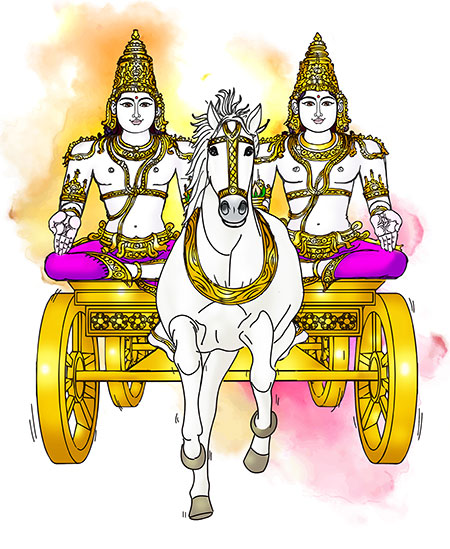
#Ashwini (" #Horsewoman") (0°00' - 13°20' Aries)
Each #star we see in the night sky is a burning hot sun, much like our own #Sun. In astronomy, the twin signs that make up the #nakshatra of Ashwini are called Alpha Arietis and Beta Arietis. Indeed, the ruling deities for Ashwini nakshatra
In #VedicAstrology are the #divine #twin physicians – the #AshwiniKumaras. While people born under Ashwini may traditionally take up a career in #medicine, they also innately carry a #healing energy and their ability to heal others through prayer is greatly enhanced.
The Ashwini Kumaras have a youthful appearance and bestow this ageless presence along with a charming innocence to those born under Ashwini. The symbol for this star is a horse’s head, which signifies power, dignity and swiftness. As the first star in the cycle of the nakshatras, Ashwini carries the energy of beginnings. Those born under Ashwini hold the ability to initiate or pioneer ideas and activities.
They must be cautious as not to begin something they cannot finish. A person born under Ashwini nakshatra is known as the quickest of all nakshatras and behaves in a direct and to-the-point manner. Just like an untamed horse, they can be confident and independent but do not like to be told what to do. Ashwini gives focus to self-improvement and wants to feel unique among its peers. This is a spontaneous star with active intelligence and sincerity.
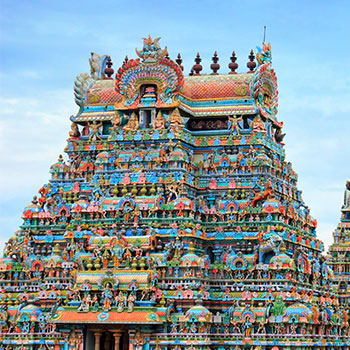
The #sacred #temple that resonates with the Ashwini nakshatra is located in a village called #Thiruthuraipoondi in Tamil Nadu, India. Those born under Ashwini star should visit this temple as frequently as possible.
The name "Sri Bhava Aushadeeswarar" temple refers to a form of Lord Shiva. "Sri" is a #mantra giving respect and good fortune, "Bhava" means state of mind and "Aushadeeswara" means Lord of medicine who cures disease. Sri Bhava Aushadeeswarar temple is a sacred vortex filled with disease-curing energy.
People born under the Ashwini nakshatra should perform a pooja or abishekam with sacred herbs (there are #64 elementary herbal substances) on their Ashwini day in order to strengthen their inner light and healing capabilities. People born under other stars can also receive healing benefits to recover from illness by performing a pooja or abishekam on Tuesday, Saturday, Ashwini star day. These rituals also benefit the holy waters surrounding the temple and create medicinal qualities in the temple pond, streams, lakes and surrounding vegetation. It is beneficial for visitors to take a holy bath in the temple pond and receive the blessings for #health benefits.
https://www.astroved.com/astropedia/en/nakshatra/ashwini-nakshatra
One person like that

https://www.hindu-blog.com/2019/08/goddess-chamunda-puja-vidhi-procedure.html
#Goddess #Chamunda Puja Vidhi – Procedure – With #Mantra
Goddess Chamunda is a fierce, deadly and powerful form of Mother Goddess Durga and she is worshipped by tantrics to achieve moksha and worldly achievements. Below is Maa Chamunda Devi puja vidhi or procedure along with mantra. This is a simple guide on how to perform Goddess Chamunda Devi Puja and is ideal for performing it at home.
Chamunda Mantra
ऐं ह्रीं क्लीं चामुण्डायै विच्चे
Aim Hreem Kleem Chamundaye Viche
When to Perform Goddess Chamunda Puja?
Ideal day to perform the puja:
Shukla Paksha Ashtami Tithi – eighth day during the light or waxing phase of moon.
Shukla Paksha Chaturdasi Tithi – fourteenth day during the light or waxing phase of moon.
Benefits of Performing Chamunda Devi Puja
Moksha or liberation.
Escape from the clutches of senses.
Good for those suffering from various addictions like alcohol, drugs etc.
Those suffering from uncontrollable lust will find relief.
Simple Goddess Chamunda Puja Vidhi
The puja should be performed early morning after sunrise or during pradosh period (1.5 hours before sunset) or at midnight.
The person performing the puja should wear red or saffron color dress.
The murti (picture, photo or painting) of Goddess Chamunda should be in the form of Jagadamba – Mother of the Universe. She should have several arms and they should be carrying various weapons. It should be placed on a red color cloth.
The puja should be performed facing north.
Copper lamp should be used and dark oil should be used to lit the lamp.
Red shoe flower should be offered.
Dhoop should be of gugal
Tilak should be of red chandan.
Sindhoor should be offered.
Uncooked wheat (gehu) should be offered.
The bhog or Prasad on the day should be prepared using Jaggery (gud). It should be shared with females after the puja.
The mantra ऐं ह्रीं क्लीं चामुण्डायै विच्चे ॥ should be chanted 108 times. The count should be kept on a red chandan mala.
All natural puja items after puja should be kept under a neem tree.
Special Pujas
To overcome alcohol, drug and other addictions the person should mix sindhoor in water and then pour it over the idol or portrait of Chamunda.
To overcome financial problems, offer uncooked masoor dal to Chamunda Devi and later keep it on the south side of the house.
To keep out fights in life, offer uncooked wheat to Chamunda and later burn it over a kapur (camphor).
1 Comments
We have built a MANTRASCOPE, now you can visually SEE Ancient #Mantras! Look at the pattern when we chant #AUM #om #Mantra - Is this a Coincidence?
Watch the full video 👉 http://y2u.be/XTsjMCOTMWw
#Hinduism #Hindu #Sound #Technology #Ancient #India #IncredibleIndia #PraveenMohan
2 Likes
https://www.youtube.com/watch?v=b1zpP2vWK4I
10 Minutes #Ancient #Mantra #Chant | #Vedic #Shiva #Nakshatra Mantra with the Blessings of Guruji
